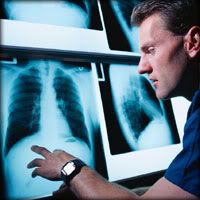Short, thin asbestos fibers contribute to the development of human malignant mesothelioma.
Title
Short, thin asbestos fibers contribute to the development of human malignant mesothelioma: pathological evidence.
Source
International Journal of Hygiene & Environmental Health. 208(3):201-10, 2005.
International Journal of Hygiene & Environmental Health. 208(3):201-10, 2005.
Based on animal studies, long and thin asbestos fibers (more than or =8 microm in length and less than or = 0.25 microm in width) have been postulated to be strongly carcinogenic inducing pleural malignant mesothelioma, while shorter, thicker fibers have been postulated to pose a lesser risk (Stanton hypothesis).
The objective of this study is to test the validity of the Stanton hypothesis through direct pathologic analysis of human mesothelioma tissue. Digested bulk tissue samples, or ashed 25 microm thick sections, or both, were prepared from lung and mesothelial tissues taken from 168 cases of human malignant mesothelioma. In these tissues, 10,575 asbestos fibers (4820 in the lung and 5755 in mesothelial tissues (1259 in fibrotic serosa and 4496 in mesotheliomatous tissue)) were identified by high-resolution analytical electron microscopy. Dimensions of these asbestos fibers were measured in printed electron micrographs.
Results were as follows: (1) long, thin asbestos fibers consistent with the Stanton hypothesis comprised only 2.3% of total fibers (247 / 10,575) in these tissues; (2) the majority (89.4%) of the fibers in the tissues examined were shorter than or equal to 5 microm in length (9454 of 10,575), and generally (92.7%) smaller than or equal to 0.25 microm in width (9808 of 10,575). (3) Among asbestos types detected in the lung and mesothelial tissues, chrysotile was the most common asbestos type to be categorized as short, thin asbestos fibers. (4) Compared with digestion technique of the bulk tissue, ashing technique of the tissue section was more effective to detect short, thin fibers.
We conclude that contrary to the Stanton hypothesis, short, thin, asbestos fibers appear to contribute to the causation of human malignant mesothelioma. Such fibers were the predominant fiber type detected in lung and mesothelial tissues from human mesothelioma patients. These findings suggest that it is not prudent to take the position that short asbestos fibers convey little risk of disease.




0 Comments:
Post a Comment
<< Home